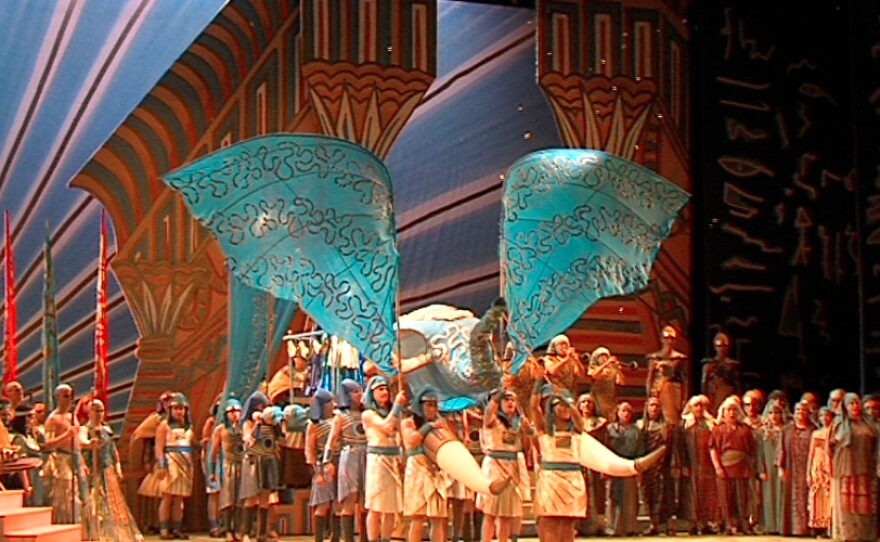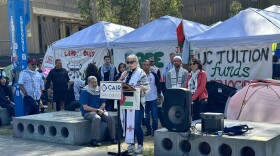ANCHOR INTRO: When Aida closes this weekend it not only marks the end of the San Diego Opera’s 2013 season but also the end of their property master’s 25 year career. KPBS arts reporter Beth Accomando goes backstage to see that a property master is responsible for everything from human sacrifices to taking out the trash. Backstage at the opera is controlled chaos. NED KRUMREY: There’s offstage singing with sometimes 50 or 60 people… there’s what we call bandas or small bands… this large theater becomes like a knife fight in a phone booth. It’s very crowded. And Ned Krumrey should know. He’s been backstage at the San Diego Opera for 25 years. But when the current production of “Aida” wraps, he’ll be retiring. NED KRUMREY: Just sitting out front as a season ticket holder and applauding and wondering how they did that, I’m just going to be a good audience member from now on. But for the next few days, he’s still working full tilt as property master for the San Diego Opera. The job includes all the things most people think of when it comes to props – swords, spears, furniture, drinking glasses. But then there are things you might not expect. NED KRUMREY: There’s an elephant in this show. Okay, it’s not a real elephant. It’s a huge stylized turquoise puppet designed by Zandra Rhodes. MUSIC from Aida NED KRUMREY: There’s a head that a guy wears in like a flag pole holder and a guy with two sticks that operates the trunk, two guys carrying the tusks… that’s how Radames makes his entrance in the triumphant return scene. Krumrey needs to make sure each piece of the pachyderm ends up in the right hands so the entrance is truly triumphant. After all, size does matter in opera. NED KRUMREY: The scale of the opera is exciting because it’s just ginormous as we say. It’s huge. But it’s also about the details. Take the human sacrifice on the steps of a pyramid. NED KRUMREY: There’s a blood pack, and a woman catches blood in a bowl and then when the curtain comes down on that we’re all about wet towels, windex, and not only shifting into the next scene but cleaning up the blood because they dance in that same area right after the blood is flown. That’s right the prop department also gets clean up duty. They’re also responsible for coming up with whatever a director asks for. Krumrey utilizes the opera’s prop warehouse, scours the Internet, and also relies on a little ingenuity. Like spray painting plastic cups in copper paint for a scene in “Aida.” NED KRUMREY: From a distance they look really great, like all of our stuff does, it’s designed to be seen at a distance. Sometimes Krumrey not only has to track down a prop like a pluckable goose for “Boris Godunov” but has to jerry-rig a temporary item to get singers through rehearsal. NED KRUMREY: The singer had to pluck feathers out of it while she sang her aria, and then we had to obviously be able to put it back together and use it night after night. So when we found out that at the production meeting… my assistant, Barry McCambridge took a ball of Styrofoam and gaffers tape and a piece of rope and we made some feet and we because you have to have something to rehearse with. Krumrey started in theater at the Old Globe. Perhaps that’s why the modern operas have been the most exciting for him to work on. NED KRUMREY: The modern operas, Streetcar Named Desire, Passion of Jonathan Way, Of Mice and Men, it tended to be some of my favorites because they are the most theatrical, there’s tons of props, and huge scene changes, like you do in the theater. CLIP orchestra warming up One of the biggest responsibilities Krumrey has, and one that most people may not be unaware of, is taking care of the nearly 60 musicians in the pit. NED KRUMREY: We set the pit. Get the right chair for the right musician, and we sweep and dump the garbage. Property master may not be the most glamorous job at the opera but it’s one that’s absolutely essential to every performance of every production. In the 25 years Krumrey’s been backstage, he’s enjoyed a lot of camaraderie with co-workers and friendships with singers. NED KRUMREY: There’s a little bit of an opera family and I’ll miss that. And the San Diego Opera will miss Krumrey’s professionalism and dedication to his craft. Beth Accomando, KPBS News. TAG: Aida continues through this weekend at the San Diego Civic Theater. Check out the behind the scenes video at KPBS-dot-ORG.
When "Aida" closes this weekend it not only marks the end of the San Diego Opera’s 2013 season but also the end of their property master’s 25-year career. Ned W. Krumrey provides a behind the scenes glimpse of what a property master is responsible for -- everything from human sacrifices to taking out the trash.
Backstage at the opera is controlled chaos.
“There’s offstage singing with sometimes 50 or 60 people. There’s what we call bandas or small bands. This large theater becomes like a knife fight in a phone booth. It’s very crowded,” explains Ned W. Krumrey.
And Ned Krumrey should know. He’s been backstage at the San Diego Opera for 25 years. But when the current production of “Aida” wraps, he’ll be retiring.
“Just sitting out front as a season ticket holder and applauding and wondering how they did that, I’m just going to be a good audience member from now on.”
But for the next few days, he’s still working full tilt as property master for the San Diego Opera. The job includes all the things most people think of when it comes to props – swords, spears, furniture, drinking glasses. But then there are things you might not expect.

“There’s an elephant in this show,” says Krumrey.
Okay, it’s not a real elephant. It’s a huge stylized turquoise puppet designed by Zandra Rhodes.
“There’s a head that a guy wears in like a flag pole holder and a guy with two sticks that operates the trunk, two guys carrying the tusks,” says Krumrey, “That’s how Radames makes his entrance in the triumphant return scene.”
Krumrey needs to make sure each piece of the pachyderm ends up in the right hands so the entrance is truly triumphant. After all, size does matter in opera.
“The scale of the opera is exciting because it’s just ginormous as we say. It’s huge.”
But it’s also about the details. Take the human sacrifice on the steps of a pyramid.
“There’s a blood pack, and a woman catches blood in a bowl and then when the curtain comes down on that we’re all about wet towels, Windex, and not only shifting into the next scene but cleaning up the blood because they dance in that same area right after the blood is flown. “
That’s right the prop department also gets clean up duty. They’re also responsible for coming up with whatever a director asks for. Krumrey utilizes the opera’s prop warehouse, scours the Internet, and also relies on a little ingenuity. Like spray painting plastic cups in copper paint for a scene in “Aida.”

“From a distance they look really great, like all of our stuff does, it’s designed to be seen at a distance.”
Sometimes Krumrey not only has to track down a prop like a pluckable goose for “Boris Godunov” but has to jerry-rig a temporary item to get singers through rehearsal.
“The singer had to pluck feathers out of it while she sang her aria, and then we had to obviously be able to put it back together and use it night after night. So when we found out that at the production meeting, my assistant, Barry McCambridge took a ball of Styrofoam and gaffers tape and a piece of rope and we made some feet and we because you have to have something to rehearse with.”
Krumrey started in theater at the Old Globe. Perhaps that’s why the modern operas have been the most exciting for him to work on.
“The modern operas, 'Streetcar Named Desire,' 'Passion of Jonathan Wade,' 'Of Mice and Men,' it tended to be some of my favorites because they are the most theatrical, there’s tons of props, and huge scene changes, like you do in the theater.”
One of the biggest responsibilities Krumrey has, and one that most people may not be unaware of, is taking care of the nearly 60 musicians in the pit.
“We set the pit. Get the right chair for the right musician, and we sweep and dump the garbage.”
Property master may not be the most glamorous job at the opera but it’s one that’s absolutely essential to every performance of every production. In the 25 years Krumrey’s been backstage, he’s enjoyed a lot of camaraderie with co-workers and friendships with singers.
“There’s a little bit of an opera family and I’ll miss that.”
And the San Diego Opera will miss Krumrey’s professionalism and dedication to his craft.
Aida continues through this weekend at the San Diego Civic Theater. Check out the behind the scenes video.
Companion viewing: (films in which behind the scenes people take center stage) "The Dresser," "F/X," "The Conversation"






